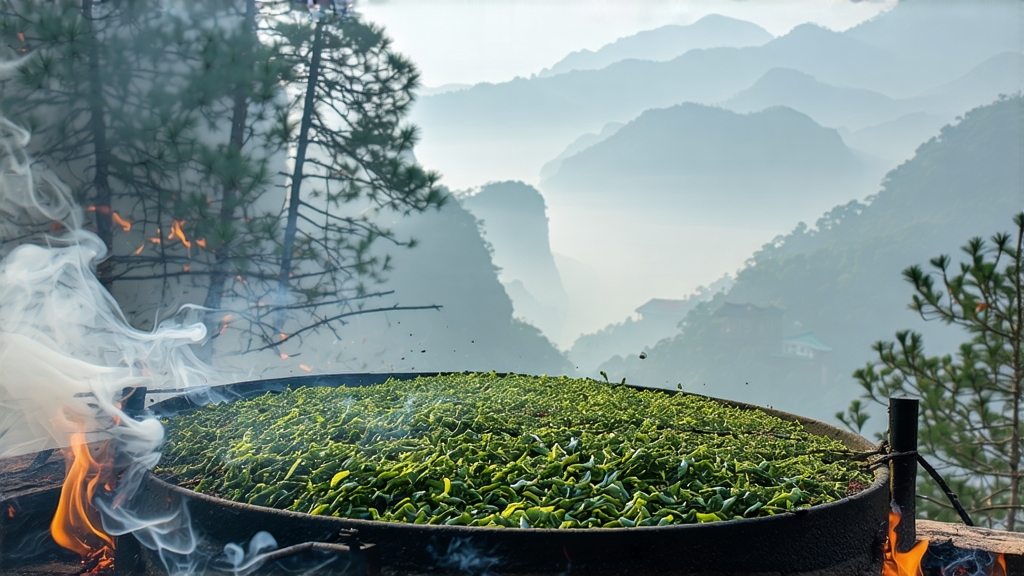
Long before English breakfast blends and Assam estates, there was Lapsang Souchong—China’s earliest black tea and the prototype that launched the global craving for fully oxidized leaves. Born in the precipitous Wuyi Mountains of northern Fujian, this tea carries within its curled, midnight-black leaves the aroma of pine resin, camphor forests, and centuries of river-borne commerce. To understand Lapsang Souchong is to witness the moment when Chinese green-tea craftsmanship pivoted toward oxidation, accidently inventing what the world now calls “black tea.”
Historical records trace the first intentional production to the late Ming dynasty, around 1604, when soldiers passing through Tongmu village delayed the usual green-tea drying schedule. Eager to save the harvest, farmers rushed the leaves over open pinewood fires, inadvertently fixing a reddish-black color and a smoky sweetness. The Dutch East India Company shipped these peculiar “bohea” (Wuyi) teas to Europe, where they were an instant sensation in London coffeehouses. By the early Qing, Lapsang Souchong had become a currency of its own, exchanged for silver and, later, opium, weaving Fujian’s mountain hamlets into the fabric of global trade.
Geographically, the tea is protected by both altitude and statute. Tongmu and the surrounding 680-square-kilometer core zone sit inside a national nature reserve threaded with narrow granite gorges, humid mists, and a microclimate that swings 10 °C between day and night. Only leaves picked within this boundary may legally bear the name “Zhengshan Xiaozhong,” literally “small leaf from the original mountain.” Outside the reserve, similar leaf styles are produced but lack the resinous terroir that defines authentic Lapsang.
Two distinct styles now coexist. The traditional “smoked” version, still crafted in Tongmu, is withered over localized pinewood fires, rolled, oxidized, then finished above a honglong (“basket dragon”) smoldering pit where fresh pine and cypress boughs release a steady stream of cool smoke. The newer “unsmoked” or “craft” style, developed for modern palates sensitive to assertive aromas, skips the final smoking phase, allowing the natural fruit and malt notes to dominate. Both, however, rely on the same cultivar—Xiaozhong, a compact, slow-growing bush whose leaves are unusually high in geraniol, lending a natural rose nuance that balances smoke or sweetness.
Harvest begins in late April, when the mountain air is still crisp and the leaves shimmer with spring oils. Standard grade uses the fourth or fifth leaf down the stem, yielding a brisker, more tannic cup, while higher grades pluck the central three leaves and the “souchong” bud, whose downy silver hairs melt into a velvety liquor. After picking, the leaves are laid on bamboo mats inside smokeless upper rooms to wither for eight to ten hours, reducing moisture to 60 %. This phase is critical; too fast and the leaf cells rupture, too slow and mountain mold sets in. Masters gauge readiness by the sound—when a leaf crackles like parchment yet remains supple, it is carried to the rolling benches.
Rolling is still done by foot in Tongmu, a ballet performed on narrow wooden ledges. The operator’s weight bruises the leaf edges, initiating oxidation while preserving the interior veins. Twenty minutes later, the leaves emerge in tight curls, sticky with sap, and are heaped into deep bamboo trays. Covered with wet cloths, they rest in a humid “fermentation” room kept at 26 °C and 85 % relative humidity. Over two hours the leaf color shifts from jade to copper to mahogany, releasing a heady perfume of honey, lychee, and pine pollen. A quick blast of 90 °C air halts oxidation, locking in the signature crimson edge and jet-black center.
For smoked Lapsang, the final act is the pinewood chamber. A shallow pit is lined with glowing embers from local Masson pine; green branches are laid on top to smolder without flame. Over this, bamboo trays of tea are stacked six layers high, allowing smoke to waft upward for six to eight hours. The tea absorbs only the aromatic volatiles, not the heavier tars, resulting in a clean, resinous sweetness reminiscent of single-malt whisky aged in Islay barrels. The finished leaf carries 3–5 % moisture and can cellar for decades, softening into dried-longan and sandalwood notes.
B